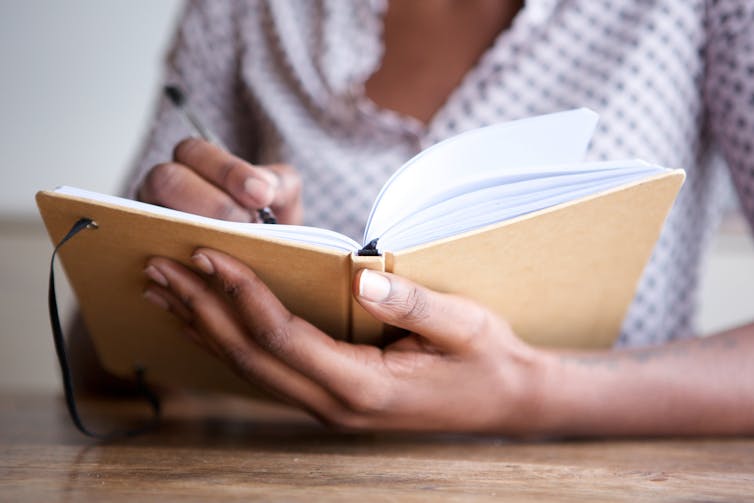
Teachers in England are struggling. A recently released government report on the working lives of teachers found that teachers’ wellbeing levels are lower than the general population. More than half of the 11,177 teachers and school leaders surveyed said that their job was negatively affecting their mental health.
Teacher wellbeing should be addressed at a structural level. If the government wants teachers to enter the profession, and continue in it, then changes around pay, working conditions and support for teachers’ mental and physical health need to happen.
In the present moment, though, there are also steps teachers can take for themselves to prioritise their wellbeing. My research focuses on how keeping a diary can be useful to teachers. It can give them a safe place to define what wellbeing means for themselves and to explore what it means in practice. What’s more, there’s no reason why this practice couldn’t be helpful for others, too.
Daily diary-keeping
I began this research project in 2018 and have worked with around 450 teachers.
I, and colleagues, asked teachers to use our diary toolkit on a daily basis for a set period of time. Depending on the phase of the project, this could be for three months, six months or a full academic year. The toolkit we gave them expands the diary beyond writing and consists of a range of creative activities – from scrapbooking and storyboarding to audio recording and gratitude lists.
We didn’t ask the teachers to share their diary entries with us. Instead, we explored the impact keeping a diary had on their wellbeing by asking them to take monthly, online wellbeing check-ins, as well as carrying out focus group sessions and online surveys.
We found that keeping a diary consistently improves teachers’ levels of wellbeing. In the first six phases of the project, 70% of our participants said using the diary toolkit improved their wellbeing – and this figure rose to 74% during COVID-19 lockdowns.
Although keeping a diary could be seen as another job on teachers’ endless to do lists, it can actually save them time in the long run. It can help provide clarity over what’s important and what isn’t. One teacher said:
I believe that diary writing is a good thing because it helps us to process our thoughts and see ourselves from a different perspective. I also think that diary writing helps us to understand what is important to us. It allows us to spot patterns in our daily struggles and focus on creating solutions.
If teachers can find out what wellbeing means to them, individually, in the pages of a diary, then they can use it to navigate their personal and professional lives. It’s a chance for teachers to get perspective on what’s working for them, as well as what isn’t. Teachers can then use this insight to make changes in their own lives, which could affect what they do inside and outside of school.

Over the years our participants have shared that the diary gives them a place to get to know themselves at a deeper level and to recognise the importance of prioritising their own wellbeing. One said:
Reflection can help give perspective and help you understand your own thoughts better. It really helped me switch off from issues I was obsessing over outside of work, when it’s really important for you to be switching off so you are better prepared to face the next day.
Our research also shows that a diary doesn’t just have to be about writing. Expanding diary-keeping beyond writing to creative exercises such as drawing can help boost wellbeing, and lets us be playful and creative along the way.
Even if you are not a teacher, you may find this style of diary-keeping useful. Here are a couple of quick and easy activities, taken from my research, to help you start – or continue – your diary-keeping journey.
1. Define your wellbeing
Write out, in your own words, what wellbeing means for you. It might be helpful to think back to a time when you felt particularly happy or content and consider what, specifically, made you feel this way. You might have been connecting with others, or feeling at peace in nature. Defining wellbeing on our own terms is helpful, because we then have something concrete to work with that is unique to us and our circumstances.
2. Write (or draw) a wellbeing recipe
If wellbeing was a cake, what are the key ingredients that make up your wellbeing on a daily basis? Think of each ingredient as a particular activity or strategy. For example, one of the ingredients might be time with family and friends.
Draw or list the ingredients in your wellbeing cake so that you have it as a visual reminder to use on a daily basis. These ingredients don’t need to be expensive or take much time. One could be as simple as drinking enough water throughout the day to keep hydrated and feel alert. Using some of your ingredients daily will help you prioritise yourself and your own needs.
3. Understand how you rest
Figure out what rest means to you. Rest can be active so, for example, reading or exercise can be included as rest because you’re using your brain in a different way.
Try drawing a rainbow, in which each colour represents an activity you use to rest. Having this visual reminder means that you don’t see your home as an extension of your workplace. Instead of wondering what to do when you get home – which could lead to you reopening your laptop, or dwelling on an issue at work – you have a range of activities to help you move away from work and rest and recharge. This helps to reclaim time away from the workplace as yours.![]()
Lucy Kelly, Associate Professor in Education, University of Bristol
This article is republished from The Conversation under a Creative Commons license. Read the original article.
